

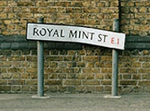 Rosemary Lane (now Royal Mint Street)
Rosemary Lane (now Royal Mint Street)
Rosemary
Lane (originally Hog Lane, or Hoggestrete) was the continuation of what
is now
Cable Street, running from the junction with Dock Street and Leman
Street towards the Tower of London. See here
for the history of the Royal Mint site - once an abbey, then the navy's
victualling yard, and then the 'New Mint'. Rosemary Lane was renamed
Royal Mint Street in
1850. In the same period, for prudish reasons, Petticoat Lane was renamed
Middlesex Street. Both are best known for their street markets - the
difference being that Rosemary Lane, as these extracts show, was
primarily for second-hand trade, and is now long-gone.
A
grant was recorded on 31 October 1631 to William Bawdrick and
Roger Hunt of the King's interest in certain tenements in Rosemary
Lane. Middlesex, the lease of which was taken by Horatio Franchotti, an
alien, but discovered and prosecuted for on His Majesty's behalf.
 Some claim that the
poet Edmund
Spenser (1552-99) was born between Rosemary Lane and East
Smithfield, though this is disputed (perhaps it was West Smithfield, in the City).
He attended Merchant
Taylors' School,
founded in the City in 1561 by Richard Hills, master of the Company.
Hills also endowed a group of cottages on the north side of Rosemary
Lane as almshouses for fourteen elderly women, who were to receive 1s.
4d. per
week, under his will, and £8. 15s. annually from
the Company. Alderman Ratcliffe of the Company added
the
benefaction of one hundred loads of timber.
Some claim that the
poet Edmund
Spenser (1552-99) was born between Rosemary Lane and East
Smithfield, though this is disputed (perhaps it was West Smithfield, in the City).
He attended Merchant
Taylors' School,
founded in the City in 1561 by Richard Hills, master of the Company.
Hills also endowed a group of cottages on the north side of Rosemary
Lane as almshouses for fourteen elderly women, who were to receive 1s.
4d. per
week, under his will, and £8. 15s. annually from
the Company. Alderman Ratcliffe of the Company added
the
benefaction of one hundred loads of timber.
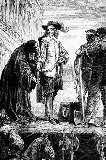 1649 - death of Richard
Brandon
1649 - death of Richard
Brandon
The
public executioner - who beheaded King Charles I and a number of
leading Royalists - died in Rosemary Lane - see more about him here. The burial registers of St
Mary Whitechapel (where he was buried - now Altab Ali Park) record
1649, June 21st. Rich. Brandon, a man out of Rosemary Lane.... this R. Brandon is supposed to have cut off the head of Charles the First.
Another
account adds:
He likewise confessed that he had thirty pounds for his pains,
all paid him in half-crowns, within an hour after the blow was given;
and that he had an orange stuck full of cloves, and a hankercher, out
of the king's pocket, so soon as he was carried off from the scaffold,
for which orange he was proffered twenty shillings by a gentleman in
Whitehall, but refused the same, and afterward sold it for ten
shillings in Rosemary Lane.
1641 - prophets of the end time
I will give unto my two witnesses, and they shall prophesy a thousand two hundred and threescore days, clothed in sackcloth (Revelation 11.3)
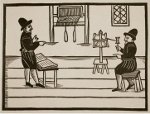 In
January 1641 two Colchester weavers, Richard Farnham and John Bull
[pictured], by a strange providence of almighty God (as a contemporary source puts it) died of the
plague in the house in Rosemary Lane where they regularly met. They
had declared themselves to be the two great prophets who must come
before the end of the world of Revelation speaks, and had been
imprisoned in Old and New Bridewell gaols respectively. A pamphlet of
1642 describes their strange prophecies, and the Scriptures
which they most blasphemously wrested, to the seducing of divers
proselytes, who yet remaine obstinate, and confidently affirme that
they are risen from the dead, and gone in vessels of bullrushes to
convert the tenne Tribes...
In
January 1641 two Colchester weavers, Richard Farnham and John Bull
[pictured], by a strange providence of almighty God (as a contemporary source puts it) died of the
plague in the house in Rosemary Lane where they regularly met. They
had declared themselves to be the two great prophets who must come
before the end of the world of Revelation speaks, and had been
imprisoned in Old and New Bridewell gaols respectively. A pamphlet of
1642 describes their strange prophecies, and the Scriptures
which they most blasphemously wrested, to the seducing of divers
proselytes, who yet remaine obstinate, and confidently affirme that
they are risen from the dead, and gone in vessels of bullrushes to
convert the tenne Tribes...
 According
to William Hurd, in A new universal history of the religious rites,
ceremonies and customs, of the whole world (Hemingway 1799, page 815), it was also in Rosemary
Lane - the same house? - that in
February 1652 cousins and journeyman-tailors John Reeve (1608-1658) and Lodowicke Muggleton
(1609-98, painting left by William Wood), influenced by the Ranters,
received 'the Third Commission' from God relating to the same text from
Revelation, of which Muggleton was to be the 'mouth'. In a public
house in The Minories, on Tower Hill, and elsewhere, they proposed a new scheme
of religion - though this was never systematic.
According
to William Hurd, in A new universal history of the religious rites,
ceremonies and customs, of the whole world (Hemingway 1799, page 815), it was also in Rosemary
Lane - the same house? - that in
February 1652 cousins and journeyman-tailors John Reeve (1608-1658) and Lodowicke Muggleton
(1609-98, painting left by William Wood), influenced by the Ranters,
received 'the Third Commission' from God relating to the same text from
Revelation, of which Muggleton was to be the 'mouth'. In a public
house in The Minories, on Tower Hill, and elsewhere, they proposed a new scheme
of religion - though this was never systematic. 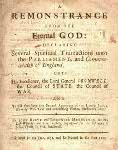 Muggleton published A true interpretation of the eleventh
chapter of the Revelation of St. John, and other texts in that book
as also many other places of Scripture whereby is unfolded, and
plainly declared the whole councel of God concerning Himself, the
Devil, and all mankinde, from the foundation of the world, to all
eternity. The
Presbyterians and Independents sought to have them restrained, and
Oliver Cromwell ordered them to be whipped through the streets;
later, after Reeve's death, Muggleton was imprisoned in the stocks.
They believed they had been given authority to anathematise false
believers, and the Quakers were particular targets: in Muggleton's
1663 tract The Neck of The Quakers Broken he
wrote He hath put the two-edged Sword of His Spirit into my
Mouth, that whosoever I pronounce cursed through my Mouth, is cursed
to Eternity. A 'tract war' followed, with rejoinders from the Quaker leader
Isaac Pennington.
Muggleton published A true interpretation of the eleventh
chapter of the Revelation of St. John, and other texts in that book
as also many other places of Scripture whereby is unfolded, and
plainly declared the whole councel of God concerning Himself, the
Devil, and all mankinde, from the foundation of the world, to all
eternity. The
Presbyterians and Independents sought to have them restrained, and
Oliver Cromwell ordered them to be whipped through the streets;
later, after Reeve's death, Muggleton was imprisoned in the stocks.
They believed they had been given authority to anathematise false
believers, and the Quakers were particular targets: in Muggleton's
1663 tract The Neck of The Quakers Broken he
wrote He hath put the two-edged Sword of His Spirit into my
Mouth, that whosoever I pronounce cursed through my Mouth, is cursed
to Eternity. A 'tract war' followed, with rejoinders from the Quaker leader
Isaac Pennington.
Muggletonian activity continued, though they never met for
organised worship, or held public meetings, or evangelised, but they had a cetrain influence - including possibly on William Blake
- and became more vocal in the 19th century. Activities centred on
reading rooms, where there was discussion, reading and singing,
including one at 7 New Street, Bishopsgate, purported to be the site of
Muggleton's birth (moved to Worship Street, Finsbury Square after the
First World War) and also in Derbyshire. The last trustee, Philip
Noakes, died in 1979 and bequeathed many records and papers. There is a very thorough website here.
1720
John
Strype's Survey
of London spoke of the small,
nasty and beggarly
streets around The Minories.
 Daniel Defoe Colonel
Jack (1722)
Daniel Defoe Colonel
Jack (1722)
Several works by, or attributed to, Daniel Defoe
(1659-1731) mention the area. Colonel
Jack had
his Breeding near Goodman's-fields and spent his
youth rambling about
Rosemary Lane and Ratcliff. After his nurse died, Jack and his
companions
lived for some years each winter in the glasshouse near Rosemary Lane;
on one
occasion they went to Rag Fair and bought two pairs of shoes and
stockings for
5d., and went on to a
boiling Cook's in Rosemary Lane where they
found cheap fare.
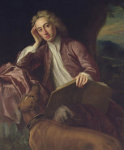 Alexander
Pope and The
Dunciad
pictured: Pope & his dog Bounce, 1718
Alexander
Pope and The
Dunciad
pictured: Pope & his dog Bounce, 1718
Pope's satire of 1728 (with subsequent editions in 1735 and 1743) was a protest against the tasteless, counterfeit, second-hand standards of the journalism and poetry of his day - the worship of the goddess Dulness. He used images of low-life venues, shifting from Grub Street in the west to Rosemary Lane's Rag Fair in the east, and included these lines:
He
added the note: Rag-fair is
a place near the Tower of London, where
old cloaths and frippery are sold. A contemporary
commentator added Much
of the
clothing that was sold there was stolen; the market was also the final
destination of all cast-off rags, in an epoch notorious for its
careless habits and for seldom or never changing its linen. See
further Pat Rogers Hacks and Dunces
(1980), exploring the detail of this imagery.
The
Daily Gazetteer,
2 August 1736
| Late
on Friday night, and early on Saturday morning, a great disturbance
happen’d in Rosemary-lane, near Rag-fair, where upwards of 150 men
assembled in a riotous manner with clubs, and other unlawful weapons,
and oblig’d all the house-keepers in Rose-mary-lane, and the parts
adjacent, to put lights in their windows, otherwise they would pull
their houses down, which put the people in the greatest consternation;
so that the whole place appear’d with lights at each window; and some
few that had none, got their windows broke to pieces. The mob went from
Rosemary-lane to Well-street by the Watch-house, and pull’d down the
house of one Welden, a cook, at the sign of the Bull and Butcher, and
broke the houshold goods all to pieces. By this time Clifford William
Phillips, of Goodman’s-fields, and Richard Farmer, of
Well-Close-square, Esqrs., two of his Majesty’s Justices of the Peace,
had procured a party of Grenadiers from the Tower, with a Commanding
Officer, in order to disperse the mob, but to no purpose, for they went
from Well-street into Rag-Fair, and demolish’d the Queen’s Head, and a
cook’s shop (the master of which is an Irish man) in Mill-yard, and a
tavern hard by, kept by Irish people: From Rag-Fair they went to
Church-lane, and demolish’d the White-Hart Ale-house, and from thence
to White-Lion-street, and demolish’d the Gentleman and Porter, they
being all houses where Irishmen used. The general cry was, while they
were committing these outrages, Down with the wild Irish. Justice
Phillips, and the commanding officers from the Tower, had their swords
drawn, and desired the mob quietly to depart; but they could not
disperse them till towards four o’clock on Saturday morning, when John
Brundit, Edward Dudley, William Ormond, Robert Maccay, Thomas Batteroy,
and Robert Page, were apprehended, and on Saturday night were committed
to Newgate. A party of his Majesty’s Horse-Guards, a party of the Horse Grenadiers, and two parties of Foot, patrole every night in the streets of Spital-fields, White-chappel, Rag-Fair, &c. Last Saturday about 16 other persons were apprehended, on suspicion of being concern’d in the said riots. |
The
Public Advertiser, 17 February 1756
Two late 18th century images of Rag Fair
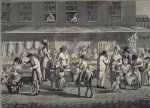 Bowles'
print of 1795 [left] is entitled High
Change, Rag Fair. It
depicts the City end of the market, near Wellclose Square. The term
'high (ex)change' was borrowed from the financial markets, to depict
the period of maximum activity, when the male stallholders would take
over from the women and children. The market traded every day except
Saturday, the Jewish Sabbath.
Bowles'
print of 1795 [left] is entitled High
Change, Rag Fair. It
depicts the City end of the market, near Wellclose Square. The term
'high (ex)change' was borrowed from the financial markets, to depict
the period of maximum activity, when the male stallholders would take
over from the women and children. The market traded every day except
Saturday, the Jewish Sabbath.
 Rowlandson's
watercolour [right] is from a few years later. The detail of the shop
signs shows the prominence of Jews in this trade:
'MOSES
MONCERA Old Hats & Wigs bought Sold or Exchanged';
'WIDOW LEVY dealer in Old Breeches'; 'Most money given for Bad Silver
MOSES ESTARDO'; PETER SMOUTCH Mony Rais'd on Good Security'. It was
commonly believed that Jews were responsible for most counterfeit
coinage. Several of the dealers standing by their
stalls are
bearded, wear long
coats and carry piles of hats on their heads, all features traditional
to the iconographic depiction of street Jews.
Rowlandson's
watercolour [right] is from a few years later. The detail of the shop
signs shows the prominence of Jews in this trade:
'MOSES
MONCERA Old Hats & Wigs bought Sold or Exchanged';
'WIDOW LEVY dealer in Old Breeches'; 'Most money given for Bad Silver
MOSES ESTARDO'; PETER SMOUTCH Mony Rais'd on Good Security'. It was
commonly believed that Jews were responsible for most counterfeit
coinage. Several of the dealers standing by their
stalls are
bearded, wear long
coats and carry piles of hats on their heads, all features traditional
to the iconographic depiction of street Jews.
In Lights
and Shadows of
London Life (1842) James Grant describes a visit to
Rag Fair:
The buyers and
sellers...are thorough
men of business. They are persons of few words; they have no time for
talking.... "How much?" says Moses, snatching a coat, or waistcoat, or
pair of trousers, from the arms or shoulders of Solomon, and giving it
a hasty inspection. "Van and sixpensh," answers the later. "Take van
and twopensh?" says the former. "No," remarks Solomon; and thereupon
Moses tosses the article of "old clo" contemptuously on his arms and
marches away with a snarlish expression of countenance.
The
articles of commerce by no means belie the name. There is no expressing
the poverty of the goods, nor yet their cheapness. A distinguished
merchant engaged with a purchaser observing me look on him with great
attention, called out to me, as his customer was going off with his
bargain, to observe that man, 'for,' says he, 'I have actually clothed
him for fourteen pence.' It was here, we believe, that
purchasers were
allowed to dip in a sack for old wigs—a penny the dip. Noblemen's suits
come here at last, after undergoing many vicissitudes.
Pennant's
book can be read here.
However, Joseph Nightingale's London
and Middlesex (1815) remarks
| The
idea which Mr.
Pennant formed of this place will be found to have been extremely
erroneous; "the poverty of the goods and their cheapness," which he
mentions, no longer exist. That a man may be wholly clothed here
for fourteen pence is a pure fiction. It is true, that during
a
part of every afternoon the middle of the street is nearly filled with
a number of Jews and other persons selling clothes, and second hand
various articles of dress at a very low rate; hut the houses in
Rosemary Lane, or the so called Rag Fair, are mostly occupied
by wholesale dealers in clothes, who used to export them to our
colonies, and to South America. In several Exchanges, or large covered
buildings, fitted up with counters, &c. there are good shops,
and
the annual circulation of money in the purliens of this place, is
really astonishing, considering the articles sold, although their
cheapness bears no kind of proportion to Mr. Pennant's
conjectures. |
|
When Sir Jeffery raised the cry of 'old wigs', the collecting of which
formed his chief occupation, he had a peculiarly droll way of clapping
his hand to his mouth, and he called 'old wigs, wigs, wigs!' in every
doorway. Some he disposed of privately, the rest he sold to the dealers
in 'Rag-fair'. In those days, 'full bottoms' were worn by almost every
person, and it was no uncommon thing to hear sea-faring persons, or
others exposed to the cold, exclaim, "Well, winter's at hand, and I
must e'en go to Rosemary-lane, and have a dip
for a wig." This 'dipping for wigs' was nothing more than putting your
hand into a large barrel and pulling one up; if you liked it you paid
your shilling, if not, you dipped again, and paid sixpence more, and so
on. Then, also, the curriers used them for cleaning the waste, &c.
off the leather, and I have no doubt would use them now if they could
get them. |
| A
missionary who recently explored Rag-fair, reported that a
man and his wife might be clothed from head to foot for from 10s. to 15s.
Another
missionary stated that 8s. would buy every article of clothing required
by
either a man or a woman, singly.... A third missionary reported: "There
is as great a
variety of articles in pattern, and shape, and size, as I think could
be found
in any draper's shop in London." The mother may go to 'Rag-fair'
with the whole of her family, both boys and girls, - yes, and her
husband, too,
and for a very few shillings deck them out from top to toe. I have no
doubt that
for a man and his wife, and five or six children, £1 at their disposal,
judiciously laid out, would purchase them all an entire change. This
may appear
to some an exaggeration: but I actually overheard a conversation in
which two
women were trying to bargain for a child's frock; the sum asked for it
was 1½d.
and
the sum offered was a penny, and they parted on the
difference.
The following is the copy of the bill delivered by the dealer to one of the missionaries, who was requested to supply a suit of clothes for a man and woman whom he had persuaded to get married several years after the right time:-
The man had been educated, and could speak no fewer than five languages; by profession he was, then, however, nothing but a dust-hill raker. The bill delivered for the bride's costume was as follows
The goods were selected by the missionary, and at the bottom of the bills the merchant marked:- "P.S.-Will be very happy to supply as many as you can find at the same prices." |
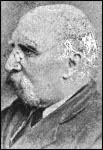 Henry
Mayhew London Labour
and the London Poor (1861)
Henry
Mayhew London Labour
and the London Poor (1861)
A Cyclopædia of the Condition
and Earnings of Those that will work, those that cannot work, and those that will not work
Henry
Mayhew was an indefatigable chronicler of the London scene. He has his
prejudices - including a strong anti-semitic streak - but provides much
valuable detail of social and economic conditions.
Rosemary
Lane Rosemary-lane,
which has in vain been re-christened Royal Mint-street, is from half to
three-quarters of a mile long—that is, if we include only the portion
which runs from the junction of Leman and Dock streets (near the London
Docks) to Sparrow-corner, where it abuts on the Minories. Beyond the
Leman-street termination of Rosemary-lane, and stretching on into
Shadwell, are many streets of a similar character as regards the street
and shop supply of articles to the poor; but as the old clothes trade
is only occasionally carried on there, I shall here deal with
Rosemary-lane proper.
Rosemary-lane,
which has in vain been re-christened Royal Mint-street, is from half to
three-quarters of a mile long—that is, if we include only the portion
which runs from the junction of Leman and Dock streets (near the London
Docks) to Sparrow-corner, where it abuts on the Minories. Beyond the
Leman-street termination of Rosemary-lane, and stretching on into
Shadwell, are many streets of a similar character as regards the street
and shop supply of articles to the poor; but as the old clothes trade
is only occasionally carried on there, I shall here deal with
Rosemary-lane proper.This lane partakes of some of the characteristics of Petticoat-lane, but without its so strongly marked peculiarities. Rosemary-lane is wider and airier, the houses on each side are loftier (in several parts), and there is an approach to a gin palace, a thing unknown in Petticoat-lane: there is no room for such a structure there. Rosemary-lane, like the quarter I have last described, has its off-streets, into which the traffic stretches. Some of these off-streets are narrower, dirtier, poorer in all respects than Rosemary-lane itself, which indeed can hardly be stigmatized as very dirty. These are Glasshouse-street, Russell-court, Hairbrine-court, Parson's-court, Blue Anchor-yard (one of the poorest places and with a half-built look), Darby-street, Cartwright-street, Peter's-court, Princes-street, Queen-street, and beyond these and in the direction of the Minories, Rosemary-lane becomes Sharp's-buildings and Sparrow-corner. There are other small non-thoroughfare courts, sometimes called blind alleys, to which no name is attached, but which are very well known to the neighbourhood as Union-court, &c.; but as these are not scenes of street-traffic, although they may be the abodes of street-traffickers, they require no especial notice. The dwellers in the neighbourhood or the off-streets of Rosemary-lane, differ from those of Petticoat-lane by the proximity of the former place to the Thames. The lodgings here are occupied by dredgers, ballast-heavers, coal-whippers, watermen, lumpen, and others whose trade is connected with the river, as well as the slop-workers and sweaters working for the Minories. The poverty of these workers compels them to lodge wherever the rent of the rooms is the lowest. As a few of the wives of the ballast-heavers, &c., are street-sellers in or about Rosemary-lane, the locality is often sought by them. About Petticoat-lane the off-streets are mostly occupied by the old clothes merchants. In Rosemary-lane is a greater street-trade, as regards things placed on the ground for retail sale, &c., than in Petticoat-lane; for though the traffic in the last-mentioned lane is by far the greatest, it is more connected with the shops, and fewer traders whose dealings are strictly those of the street alone resort to it. Rosemary-lane, too, is more Irish. There are some cheap lodging-houses in the courts, &c., to which the poor Irish flock; and as they are very frequently street sellers, on busy days the quarter abounds with them. At every step you hear the Erse tongue, and meet with the Irish physiognomy; Jews and Jewesses are also seen in the street, and they abound in the shops. The street-traffic does not begin until about one o'clock, except as regards the vegetable, fish, and oyster-stalls, &c.; but the chief business of this lane, which is as inappropriately as that of Petticoat is suitably named, is in the vending of the articles which have often been thrown aside as refuse, but from which numbers in London wring an existence. One side of the lane is covered with old boots and shoes; old clothes, both men's, women's, and children's; new lace for edgings; and a variety of cheap prints and muslins (also new); hats and bonnets; pots, and often of the commonest kinds; tins; old knives and forks, old scissors, and old metal articles generally; here and there is a stall of cheap bread or American cheese, or what is announced аs American; old glass; different descriptions of second-hand furniture of the smaller size, such as children's chairs, bellows, &c. Mixed with these, but only very scantily, are a few bright-looking swag-barrows, with china ornaments, toys, &c. Some of the wares are spread on the ground on wrappers, or pieces of matting or carpet; and some, as the pots, are occasionally placed on straw. The cotton prints are often heaped on the ground; where are also ranges or heaps of boots and shoes, and piles of old clothes, or hats, or umbrellas. Other traders place their goods on stalls or barrows, or over an old chair or clothes-horse. And amidst all this motley display the buyers and sellers smoke, and shout, and doze, and bargain, and wrangle, and eat and drink tea and coffee, and sometimes beer. Altogether Rosemary-lane is more of a street market than is Petticoat-lane. This district, like the one I have first described, is infested with young thieves and vagrants from the neighbouring lodging-houses, who may be seen running about, often bare footed, bare-necked, and shirtless, but "larking" one with another, and what mav be best understood as "full of fun." In what way these lads dispose of their plunder, and how their plunder is in any way connected with the trade of these parts, I shall show in my account of the Thieves. One pickpocket told me that there was no person whom he delighted so much to steal from as any Petticoat-laner with whom he had professional dealings! In Rosemary-lane there is a busy Sunday morning trade; there is a street trade, also, on the Saturday afternoons, but the greater part of the shops are then closed, and the Jews do not participate in the commerce until after sunset. The two marts [Petticoat Lane & Rosemary Lane] I have thus fully described differ from all other street-markets, for in these two second-hand garments, and second-hand merchandize generally (although but in a small proportion), are the grand staple of the traffic. At the other street-markets, the second-hand commerce is the exception. Of the Street-Sellers of Petticoat and Rosemary-Lanes Immediately connected with the trade of the central mart for old clothes are the adjoining streets of Petticoat-lane, and those of the not very distant Rosemary-lane. In these localities is a second-hand garment-seller at almost every step, but the whole stock of these traders, decent, frowsy, half-rotten, or smart and good habilments, has first passed through the channel of the Exchange. The men who sell these goods have all bought them at the Exchange—the exceptions being insignificant—so that this street-sale is but an extension of the trade of the central mart, with the addition that the wares have been made ready for use. A
cursory observation might lead an inexperienced person to the
conclusion, that these old clothes traders who are standing by the
bundles of gowns, or lines of coats, hanging from their doorposts, or
in the place from which the window has been removed, or at the sides of
their houses, or piled in the street before them, are drowsy
people,
for they seem to sit among their property, lost in thought, or caring
only for the fumes of a pipe. But let any one indicate, even by an
approving glance, the likelihood of his becoming a customer, and see if
there be any lack of diligence in business. Some, indeed,
pertinaciously invite attention to their wares; some (and often
welldressed women) leave their premises a few yards to accost a
stranger pointing to a "good dresscoat" or "an excellent frock" (coat).
I am told that this practice is less pursued than it was, and it seems
that the solicitations are now addressed chiefly to strangers. These
strangers, persons happening to be passing, or visitors from curiosity,
are at once recognised; for as in all not very extended localities,
where the inhabitants pursue a similar calling, they are, as regards
their knowledge of one another, as the members of one family. Thus a
stranger is as easily recognised as he would be in a little rustic
hamlet where a strange face is not seen once a quarter. Indeed so
narrow are some of the streets and alleys in this quarter, and so
little is there of privacy, owing to the removal, in warm weather, even
of the casements, that the room is commanded in all its domestic
details; and as among these details there is generally a further
display of goods similar to the articles outside, the jammedup places
really look like a great family house with merely a sort of channel,
dignified by the name of a street, between the right and left suites of
apartments. In
one off-street, where on a Sunday there is a
considerable demand for Jewish sweet-meats by Christian boys, and a
little sly, and perhaps not very successful gambling on the part of the
ingenuous youth to possess themselves of these confectionaries at the
easiest rate, there are some mounds of builders' rubbish upon which, if
an inquisitive person ascended, he could command the details of the
upper rooms, probably the bed chambers—if in their crowded apartments
these traders can find spaces for beds. It must not be supposed that old clothes are more than the great staple of the traffic of this district. Wherever persons are assembled there are certain to be purveyors of provisions and of cool or hot drinks for warm or cold weather. The interior of the Old Clothes Exchange has its oyster-stall, its fountain of ginger-beer, its coffeehouse, and ale-house, and a troop of peripatetic traders, boys principally, carrying trays. Outside the walls of the Exchange this trade is still thicker. A Jew boy thrusts a tin of highly-glazed cakes and pastry under the people's noses here; and on the other side a basket of oranges regales the same sense by its proximity. At the next step the thoroughfare is interrupted by a gaudylooking ginger-beer, lemonade, raspberryade, and nectar fountain; "a halfpenny a glass, a halfpenny a glass, sparkling lemonade!" shouts the vendor as you pass. The fountain and the glasses glitter in the sun, the varnish of the wood-work shines, the lemonade really does sparkle, and all looks clean—except the owner. Close by is a brawny young Irishman, his red beard unshorn for perhaps ten days, and his neck, where it had been exposed to the weather, a far deeper red than his beard, and he is carrying a small basket of nuts, and selling them as gravely as if they were articles suited to his strength. A little lower is the cry, in a woman's voice, "Fish, fried fish! Ha'penny; fish, fried fish!" and so monotonously and mechanically is it ejaculated that one might think the seller's life was passed in uttering these few words, even as a rook's is in crying "Caw, caw." Here I saw a poor Irishwoman who had a child on her back buy a piece of this fish (which may be had "hot" or "cold"), and tear out a piece with her teeth, and this with all the eagerness and relish of appetite or hunger; first eating the brown outside and then sucking the bone. I never saw fish look firmer or whiter. That fried fish is to be procured is manifest to more senses than one, for you can hear the sound of its being fried, and smell the fumes from the oil. In an open window opposite frizzle on an old tray, small pieces of thinly-cut meat, with a mixture of onions, kept hot by being placed over an old pan containing charcoal. In another room a mess of batter is smoking over a grate. "Penny a lot, oysters," resounds from different parts. Some of the sellers command two streets by establishing their stalls or tubs at a corner. Lads pass, carrying sweet-stuff on trays. I observed one very dark-eyed Hebrew boy chewing the hard-bake he vended—if it were not a substitute—with an expression of great enjoyment. Heaped--up trays of fresh-looking sponge-cakes are carried in tempting pyramids. Youths have stocks of large hardlooking biscuits, and walk about crying, "Ha'penny biscuits, ha'penny; three a penny, biscuits;" these, with a morsel of cheese, often supply a dinner or a luncheon. Dates and figs, as dry as they are cheap, constitute the stock in trade of other street-sellers. "Coker-nuts" are sold in pieces and entire; the Jew boy, when he invites to the purchase of an entire nut, shaking it at the ear of the customer. I was told by a costermonger that these juveniles had a way of drumming with their fingers on the shell so as to satisfy a "green" customer that the nut offered was a sound one. Such
are the summer eatables and drinkables which I have lately seen vended
in the Petticoat-lane district. In winter there are, as long as
daylight
lasts—and in no other locality perhaps does it last so short a
time—other street provisions, and, if possible, greater zeal in selling
them, the hours of business being circumscribed. There is then the
potato-can and the hot elder-wine apparatus, and smoking pies and
puddings, and roasted apples and chestnuts, and walnuts, and the
several fruits which ripen in the autumn—apples, pears, &c. Hitherto
I have spoken only of such eatables and drinkables as are ready for
consumption, but to these the trade in the Petticoat-lane district is
by no means confined. There is fresh fish, generally of the cheaper
kinds, and smoked or dried fish (smoked salmon, moreover, is sold
ready cooked), and costermongers' barrows, with their loads of
green
vegetables, looking almost out of place amidst the surrounding
dinginess. The cries of "Fine cauliflowers," "Large penny cabbages,"
"Eight a shilling, mackarel," "Eels, live eels," mix strangely with the
hubbub of the busier street. Other
street-sellers also abound. You
meet one man who says mysteriously, and rather bluntly, "Buy a good
knife, governor." His tone is remarkable, and if it attract attention,
he may hint that he has smuggled goods which he must sell anyhow. Such
men, I am told, look out mostly for seamen, who often resort to
Petticoat-lane; for idle men like sailors on shore, and idle
uncultivated men often love to lounge where there is bustle. Pocket and
pen knives and scissors, "Penny a piece, penny a pair," rubbed over
with oil, both to hide and prevent rust, are carried on trays, and
spread on stalls, some stalls consisting of merely a tea-chest lid on a
stool. Another man, carrying perhaps a sponge in his hand, and
well-dressed, asks you, in a subdued voice, if you want a good razor,
as if he almost suspected that you meditated suicide, and were looking
out for the means! This is another ruse to introduce smuggled (or
"duffer's") goods. Account-books are hawked. "Penny-a-quire," shouts
the itinerant street stationer (who, if questioned, always declares he
said "Penny half quire"). "Stockings, stockings, two pence a pair."
"Here's your chewl-ry; penny, a penny; pick'em and choose 'em." [I may
remark that outside the window of one shop, or rather parlour, if there
be any such distinction here, I saw the handsomest, as far as I am able
to judge, and the best cheap jewellery I ever saw in the streets.]
"Pencils, sir, pencils; steel-pens, steel-pens; ha'penny, penny;
pencils, steel-pens; sealing-wax, wax, wax, wax!" shouts one, "Green
peas, ha'penny a pint!" cries another. These
things, however, are
but the accompaniments of the main traffic. But as such things
accompany all traffic, not on a small scale, and may be found in almost
every metropolitan thoroughfare, where the police are not required, by
the householders, to interfere, I will point out, to show the
distinctive character of the street-trade in this part, what is not
sold and not encouraged. I saw no old books. There were no flowers; no
music, which indeed could not be heard except at the outskirts of the
din; and no beggars plying their vocation among the trading class. Another
peculiarity pertaining alike to this shop and street locality is, that
everything is at the veriest minimum of price; though it may not be
asked, it will assuredly be taken. The bottle of lemonade which is
elsewhere a penny is here a halfpenny. The tarts, which among the
street-sellers about the Royal Exchange are a halfpenny each, are here
a farthing. When lemons are two a-penny in St. George's-market,
Oxford-street, as the long line of street stalls towards the western
extremity is called—they are three and four a-penny in Petticoat and
Rosemary lanes. Certainly there is a difference in size between the
dearer and the cheaper tarts and lemons, and perhaps there is a
difference in quality also, but the rule of a minimized cheapness has
no exceptions in this cheaptrading quarter.... further description of Petticoat Lane follows - and see here for detailed accounts of various types of second-hand trade |
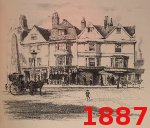
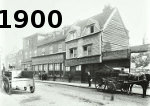
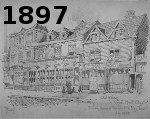
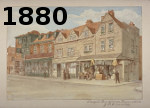
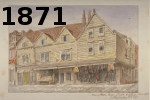 There are further
Victorian accounts of the area in Walter Thornbury Old and
New London,
vol.2 (1878) and Henry Wheatley London
Past and Present (1891), who
comments Royal Mint Street has hardly so evil a
reputation as Rosemary Lane, but it is a squalid place, lined with old
clothes' shops and stalls, and on Sunday mornings the aspect of Rag
Fair, as it is still commonly called, is anything but edifying. A
revised version of this work by Wheatley and T.R. Way, Later Reliques
of Old London (G Bell 1897) includes this 1887 plate of Sharpe's Row, numbers 2, 3, 3½ & 4, in Royal Mint Street. Right
are three other drawings and sketches from the period - 1871 by Charles
James Richardson, 1880 by John Philipps Emslie and 1897 by Robert
Randoll - and a photograph of 1900. The
market continued in Royal Mint Street until 1911, but the area became dominated by railway activity [see below]. Petticoat Lane, of course, is still going strong!
There are further
Victorian accounts of the area in Walter Thornbury Old and
New London,
vol.2 (1878) and Henry Wheatley London
Past and Present (1891), who
comments Royal Mint Street has hardly so evil a
reputation as Rosemary Lane, but it is a squalid place, lined with old
clothes' shops and stalls, and on Sunday mornings the aspect of Rag
Fair, as it is still commonly called, is anything but edifying. A
revised version of this work by Wheatley and T.R. Way, Later Reliques
of Old London (G Bell 1897) includes this 1887 plate of Sharpe's Row, numbers 2, 3, 3½ & 4, in Royal Mint Street. Right
are three other drawings and sketches from the period - 1871 by Charles
James Richardson, 1880 by John Philipps Emslie and 1897 by Robert
Randoll - and a photograph of 1900. The
market continued in Royal Mint Street until 1911, but the area became dominated by railway activity [see below]. Petticoat Lane, of course, is still going strong!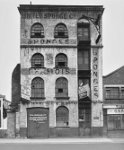 At 41 Royal Mint Street stood the warehouse of the United Sponge Company (right in 1971 a few years before demolition). A. Nunes-Vais traded as the United
Sponge Company, importers and dealers in sponges,
at 77 Minories (where Harold May / Marks / Marcuson also traded as the
National Sponge Company), and together with May as importers
and dealers in chamois leathers at
11 The Crescent, Minories. Henry Mayhew had commented, in 1851, this
[sponge selling] is one of the street-trades which has long been in the hands of the
Jews, and, unlike the traffic in pencils, sealing wax, and other
articles of which I have treated, it remains so principally still,
and he lists several dealers, including
Simon Marks, of 10 Middlesex Street. In 1922 Nunes-Vais and May were
among the 'aliens' granted exemption from s7
of the Aliens Restriction (Amendment) Act 1919 and permitted to change their trading names. In 1944 it was
reported that in the long years of its existence the United Sponge
Company has been able to establish extensive business connections in
all countries of the Eastern Mediterranean for the regular supply of
all varieties of sponges. It ceased trading in 1973 (together with
the Universal Sponge Company, of the same address). See here for the Bahamas sponge trade in the 19th century.
At 41 Royal Mint Street stood the warehouse of the United Sponge Company (right in 1971 a few years before demolition). A. Nunes-Vais traded as the United
Sponge Company, importers and dealers in sponges,
at 77 Minories (where Harold May / Marks / Marcuson also traded as the
National Sponge Company), and together with May as importers
and dealers in chamois leathers at
11 The Crescent, Minories. Henry Mayhew had commented, in 1851, this
[sponge selling] is one of the street-trades which has long been in the hands of the
Jews, and, unlike the traffic in pencils, sealing wax, and other
articles of which I have treated, it remains so principally still,
and he lists several dealers, including
Simon Marks, of 10 Middlesex Street. In 1922 Nunes-Vais and May were
among the 'aliens' granted exemption from s7
of the Aliens Restriction (Amendment) Act 1919 and permitted to change their trading names. In 1944 it was
reported that in the long years of its existence the United Sponge
Company has been able to establish extensive business connections in
all countries of the Eastern Mediterranean for the regular supply of
all varieties of sponges. It ceased trading in 1973 (together with
the Universal Sponge Company, of the same address). See here for the Bahamas sponge trade in the 19th century.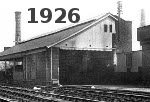

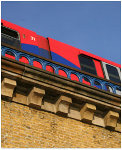
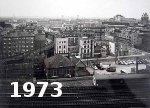 The
Royal Mint Street Goods Station [left in 1926] was built on the site previously
occupied by the London & Blackwall Railway Minories station (see here for its history). It
closed in 1949 and Tower Hill DLR station now occupies this site. (The
1973 view, right, shows the railway looking south, with the spur to London Docks
through the Peabody estate still visible before its demolition.)
The
Royal Mint Street Goods Station [left in 1926] was built on the site previously
occupied by the London & Blackwall Railway Minories station (see here for its history). It
closed in 1949 and Tower Hill DLR station now occupies this site. (The
1973 view, right, shows the railway looking south, with the spur to London Docks
through the Peabody estate still visible before its demolition.) 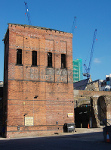

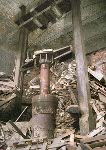
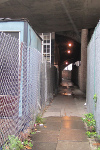
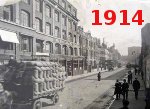 All that is left is the viaduct itself, and on the
corner of Royal Mint Street and [right in 1914] Mansell Street, a hydraulic accumulator
tower [left].
This was built in two stages between 1894 and 1913, and stored
water held under pressure by a weighted piston, providing hydraulic
power to operate turntables and a lift to move wagons on and
off the viaduct. The faded lettering proclaims 'London Midland &
Scottish
Railway City Goods Station and Bonded Stores'. [The third picture on
the left shows a hydraulic accumulator which performed a similar
function at Bishopsgate goods station, where the new Shoreditch High
Street station on the London Overground is now located; see here for an earlier example of hydraulic railway technology.] Also right is
'the Alleyway', on the site of Abel's Buildings [named after its first
ground landlord - also known as White's Buildings], which runs under
the railway between Royal Mint and Chambers Streets, where fly-tipping
and other rubbish accumulates.
All that is left is the viaduct itself, and on the
corner of Royal Mint Street and [right in 1914] Mansell Street, a hydraulic accumulator
tower [left].
This was built in two stages between 1894 and 1913, and stored
water held under pressure by a weighted piston, providing hydraulic
power to operate turntables and a lift to move wagons on and
off the viaduct. The faded lettering proclaims 'London Midland &
Scottish
Railway City Goods Station and Bonded Stores'. [The third picture on
the left shows a hydraulic accumulator which performed a similar
function at Bishopsgate goods station, where the new Shoreditch High
Street station on the London Overground is now located; see here for an earlier example of hydraulic railway technology.] Also right is
'the Alleyway', on the site of Abel's Buildings [named after its first
ground landlord - also known as White's Buildings], which runs under
the railway between Royal Mint and Chambers Streets, where fly-tipping
and other rubbish accumulates.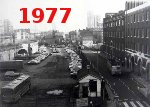
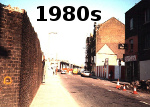
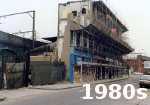
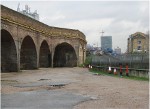 In
2010 Zog Brownfield Ventures
put forward ambitious plans to develop
this run-down site, with a hotel and community facilities. They argue
that although the accumulator tower is a 'heritage
asset' forming an important part of the historical railway
infrastructure of the area (and still contains the pulleys and other
equipment), it is in a poor state, compromised for many years by its
shabby surroundings [car park 1977, the street in 1980s during demolitions];
that permission for demolition had previously
been granted; and that its loss would be mitigated by the public value
of the
overall development. The application received planning approval in
December 2011. However, another developer has now taken on this site.
In
2010 Zog Brownfield Ventures
put forward ambitious plans to develop
this run-down site, with a hotel and community facilities. They argue
that although the accumulator tower is a 'heritage
asset' forming an important part of the historical railway
infrastructure of the area (and still contains the pulleys and other
equipment), it is in a poor state, compromised for many years by its
shabby surroundings [car park 1977, the street in 1980s during demolitions];
that permission for demolition had previously
been granted; and that its loss would be mitigated by the public value
of the
overall development. The application received planning approval in
December 2011. However, another developer has now taken on this site.
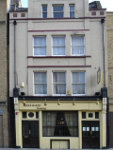
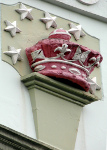
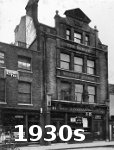 Of the pubs along Rosemary Lane / Royal Mint Street, two buildings remain: Ieft - at no.47, the Crown and Seven Stars (known by this name from c1888, now the Artful Dodger - note the roofline inscription 'Warehouse', and the crest below); and right - the City of Carlisle at 61, rebuilt in the 1860s, but retaining a 1620 terracotta insert, and later known as The Dublin [right, 1930s]. Until its lamented closure in 2013 it was a stylish French restaurant called 'Rosemary Lane'.
Of the pubs along Rosemary Lane / Royal Mint Street, two buildings remain: Ieft - at no.47, the Crown and Seven Stars (known by this name from c1888, now the Artful Dodger - note the roofline inscription 'Warehouse', and the crest below); and right - the City of Carlisle at 61, rebuilt in the 1860s, but retaining a 1620 terracotta insert, and later known as The Dublin [right, 1930s]. Until its lamented closure in 2013 it was a stylish French restaurant called 'Rosemary Lane'.
Back to History page